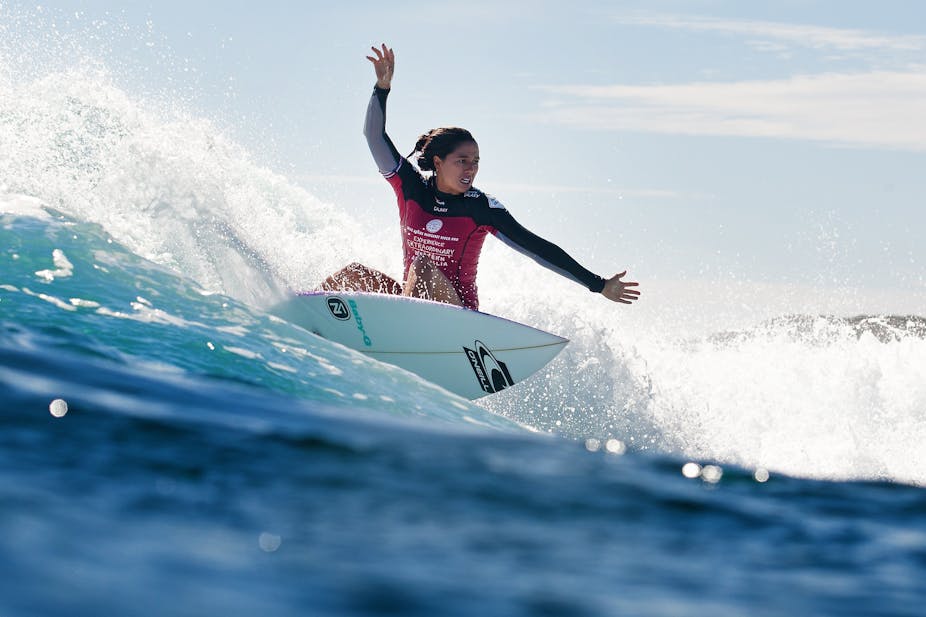The surfboard industry remains a paradox – existing in a shared but parallel world of high-tech and traditional design and production practices. At once surfboards can be high-performance and nostalgic, machine-made and handmade by global brands and local craft-based manufacturers.
When the elite professional surfing world championship 2014 Rip Curl Pro comes to Victoria’s Bells Beach (April 16-27), many of us will keenly observe what the pros are riding. So what exactly are the key elements of surfboard design?
Surfboard design elements
The typical surfboard preferred by many of the competitors, unless the surf is exceptionally huge, will be a performance “shortboard”. It will be a few inches either side of six-feet long (yes, surfing resolutely measures everything in feet and inches), probably constructed out of a polyurethane (PU) foam blank (or core) and “glassed” (sealed) with a polyester resin fiberglass composite.
The plan-shape (or template) and overall length are important but there are many other design elements the surfboard “shaper” (or designer/maker) will consider to create the optimal board to suit a specific surfer and the wave conditions.
The design elements include:
Rocker: the longitudinal bottom curve of the board resulting in the desired nose and tail lift.
Bottom cross-section contours: typically a performance shortboard, from nose to tail, consists of a single concave into a double concave.
Rail profiles: the changing shape of the continuous side edge of the board is critical to how the board holds and releases in a wave; making sure the nose doesn’t “catch”, the mid-lengths “grip” and the tail releases water for manoeuvrability.
Volume and weight: board thickness and how it is distributed throughout the board will determine the feel of the board in the water. Professional surfers prefer their surfboards built light and thin. These boards have less volume (to float) and less durability than most recreational surfers require. A consequence of this fragility is the not uncommon sight of a board snapping during competitive events.
Fin design and placement: three fin or quad fin set-ups predominate. A range of variables include the fin shape, angle and placement on the board.
Traditional preference

Combined, these elements offer a variety of interacting variables that result in a complex three-dimensional form. Much of the refinement in surfboard design has evolved incrementally through a process of trial and error. Testing incremental variations and combinations of design elements.
Whereas design has been tweaked for maximum performance, the board’s construction methods and materials remain relatively unchanged since the advent of hand lay-up fiberglass composite construction methods first popularised in the 1950s.
Many professional surfers prefer surfboards to be made from “traditional” surfboard materials based upon PU foam blanks and glassed with a polyester resin fiberglass composite. This preference for the traditional is partly due to the flex and feel of PU polyester surfboards on the wave, despite the fact that more recently developed EPS epoxy boards can be built stronger, lighter and are more durable.
PU boards can also be built faster and cheaper, allowing for an iterative process between the shaper and surfer to work on incremental design changes to maximise competitive performance.
Shapers will either hand shape the blank using traditional craft skills as demonstrated in the video above or through computer aided design (CAD) software which produces a machine code file for a specialised computer numerical controlled (CNC) surfboard shaping machine.

Machine shaped boards offer advantages in terms of reducing labour costs, greater dimensional accuracy and the ability to replicate standardised popular board designs. But many still advocate the merits of hand shaped boards and value the years of acquired knowledge and skills a shaper brings to a board design project. Still, many shapers will often combine machine and hand shaped boards in their repertoire.
Tradition meets high-tech
The Australian surfboard industry is full of contradictions. Australia is a global leader in the design and marketing of surfboard equipment. In the 1980s Australian Simon Anderson’s three-fin surfboard design transformed high performance surfing, and more recently Australian-originated firms Fin Control Systems (FCS), Global Surf Industries and Firewire Surfboards have transformed production techniques and marketing.
But the industry is made up of mostly small, localised factories with designer/ makers hand-crafting high quality surfboards, often customised to individual surfers’ needs.

While professional surfers are pursuing high performance board designs based on handcrafted and traditional construction methods and materials, many recreational surfers are embracing boards made from new and innovative construction methods and materials.
Some shapers are exploring the use of hybrid composites materials including natural materials, bamboo, timber veneer and cork. Dave Porter from Treehouse Handshapes builds lightweight durable surfboards incorporating stringerless EPS cores with timber veneer decks.
A recent experimental design of his is an asymmetrical surfboard that is glassed with an epoxy and natural flax fiber composite.
Retro surfboard designs from the 60s, 70s and 80s are again gaining popularity. Single-fin boards and longboards (mals, logs, nose riders, trackers and sliders), along with revised and updated designs of past curiosities, such as the finless “ironing board” alaia and the impossibly quick but unlikely looking mini simmons, now mingle in board racks alongside more standard performance shortboards described above.
These boards appeal to surfers who savour the essence of the experience and who aren’t necessarily driven by the pursuit of high-performance manoeuvres in the most critical part of the wave. These “experience surfers” seek new and varied experiences that offer a means of experimentation, self-expression and enjoyment.
Thanks to them the diversity of surfboard design and has never been greater. And that’s a diversity worth celebrating.
2014 Rip Curl Pro Bells Beach surf competition takes place April 16 - 27.

